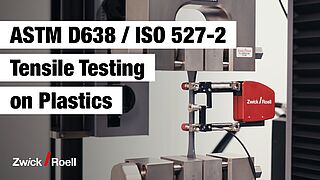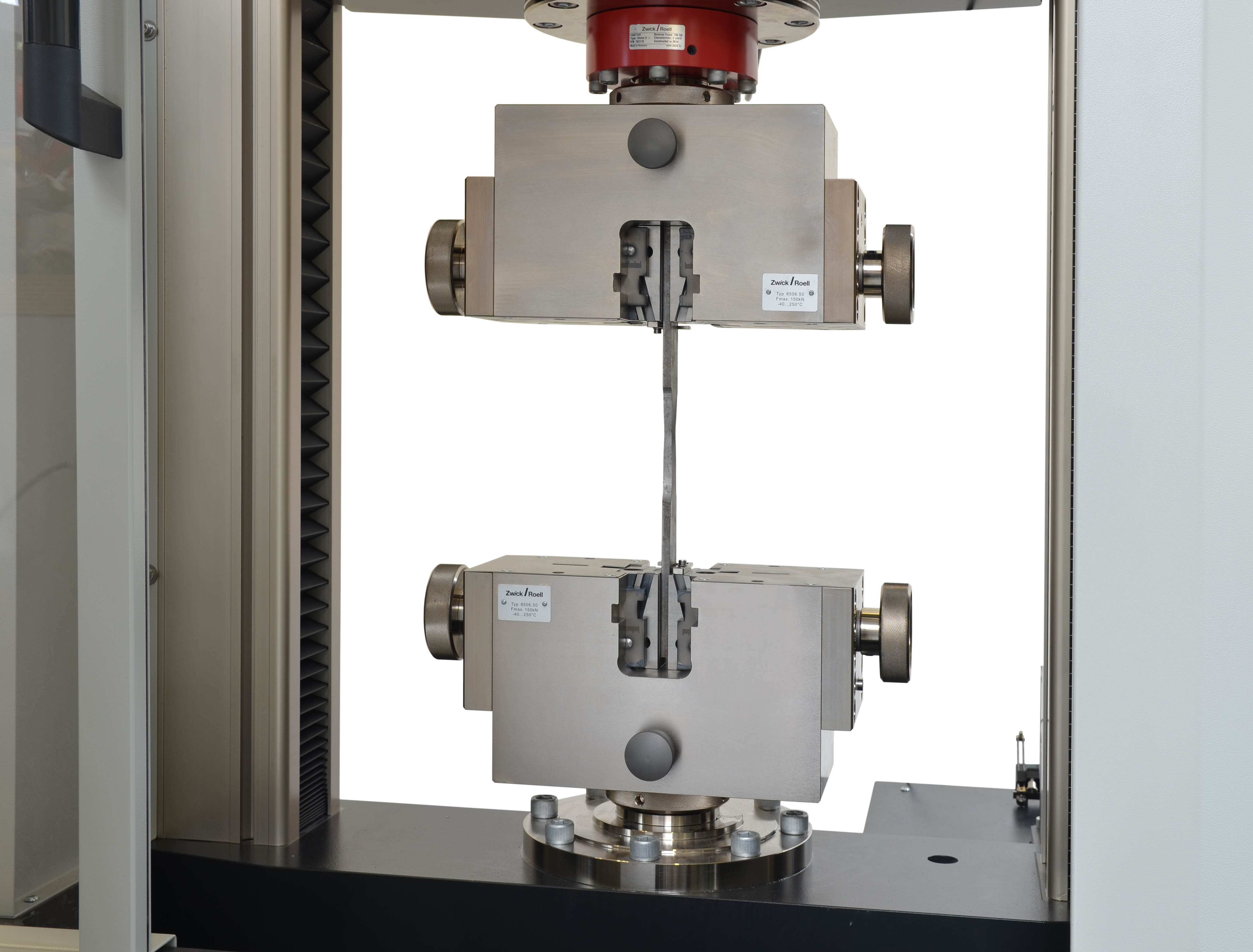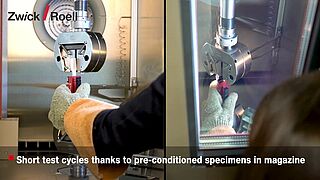塑膠的拉伸特性-根據 ASTM D638
ASTM D638 標準描述了測定增強和非增強塑膠拉伸性能的測試方法。 它有助於測定基本機械特性,包括拉伸應力、應變、拉伸模量、拉伸強度、降伏拉伸強度,以及斷裂拉伸強度。
ASTM D638 包含有關試樣形狀和試樣尺寸、包括環境條件的測試程序以及相應試驗機和延伸計準確度要求的資訊。 下列資訊提供了全面的概述。 為確保拉伸測試符合 ASTM D638 標準,請參考完整標準。
雖然 ASTM D638與其之對應的 ISO 相關規範 ISO 527-1 / ISO 527-2 在技術層面上具有等效性,但由於試樣形狀、測試程序以及結果的判定方式存在差異,因此兩者的測試結果並無法完全可比。 針對厚度小於 1 mm 的薄膜與薄片所做塑膠拉伸測試,可參照 ASTM D882 或 ISO 527-3 標準。
ASTM D638 和 ISO 527-1/2 有何不同?
ASTM D638 和 ISO 527-1/2 為測試塑膠拉伸性能的兩個常用標準。 ASTM D638 呈現的是拉伸特性的實用特徵,而 ISO 527 標準的原則呈現是各實驗室、各公司與各地區測試結果的高度可再現性。
比較 ASTM D638 和 ISO 527 時需要注意以下這些重要差異:
- ISO 和 ASTM 定義並允許使用不同的試樣尺寸:
ASTM D638 Type I 型是硬質塑料的首選試樣,形狀為啞鈴形,總長度為 165 毫米,厚度為 3.2 毫米(1/8 英寸),標距為 50 毫米(2 英寸),這仍然與常見組件材料厚度相對相似,同時支援良好的應變測量準確度。
符合 ISO 527-2 的首選啞鈴試樣是 Type 1A 型(射出),總長度為 170 毫米,厚度為 4 毫米,標距為 75 或 50 毫米。ASTM 標準描述了五種試樣類型,而 ISO 將試樣限制為兩種類型,以實現高度的比較精度。 - 標準中規定的測試速度和應變率也可能有所不同。
- 在許多情況下,ASTM D638 對應變測量準確度的要求低於 ISO 527。
- 不同測試指定的環境條件(例如溫度和濕度)可能會有所不同。
- 兩個標準在資料分析和測定結果方面的要求可能有所不同。
ASTM D638 是否為適用於我目前測試的正確標準?
在聚合物測試中,根據材料和形式,拉伸測試有不同的標準化測試方法:
- ASTM D638:對非增強及短纖維增強塑膠進行拉伸測試。ASTM D638 標準適用於厚度 1.0 至 14 mm(0.55 英吋)之試樣。
- ASTM D882:厚度未滿 1.0 毫米(0.04 英吋)塑膠薄膜及片材拉伸測試。 為此,提供有特殊試樣及測試方法,滿足薄膜測試的特殊要求。 厚度超過 14 毫米(0.55 英吋)的材料必須以機械加工縮小。
- ASTM D412:硫化橡膠及熱塑性彈性體拉伸測試
- ASTM D1708:微拉伸試樣拉伸測試
- ASTM D5323:拉伸試驗中聚乙烯地工止水膜 2% 正割模量測定
- ASTM D2290:塑膠管表觀環向拉伸強度
- ASTM D3039:GRC 或 CRC 等聚合物基複合材料拉伸性能標準測試法。 根據層壓材料或織物的方向和結構,這些材料可具有非常不同的特性。 因此,它們通常需要特殊的試樣和測試方法
- ASTM D3916:測定拉擠成型玻璃纖維增強塑膠棒的拉伸性能
- ASTM D7205:纖維增強聚合物基複材棒拉伸性能的測試方法
- ASTM D751:塗層織物的拉伸測試
- ASTM D1623:硬質發泡塑膠拉伸和拉伸黏合性能的測試方法
- ASTM D3574 測試 E:發泡材的拉伸測試
- ASTM D897:黏合劑的拉伸性能
ASTM D638 試樣尺寸/試樣類型
根據ASTM D638進行測試的試樣依照以下類型分類:
- 首選的測試試片是啞鈴 I 型,其厚度為 3.2 mm(1/8 inches),標距長度為 50 mm(2 inches),仍然與常見的組件材料厚度相對相似,同時具有良好的應變測量準確度。
- 假設透過使用 I 型試片,不能在試片的窄平行部分產生斷裂,ASTM D638 建議使用 II 型試片,其中窄平行部分的寬度顯著減小。
- ASTM D638 Type III - 如果可透過機械加工取得材料厚度超過7mm的試樣,則使用 Type III 試樣。 在此情況下,窄平行部分的寬度以及肩寬和整體長度皆增加,以確保試樣的厚度保持小於試樣的寬度。 至於薄板厚度超過14mm的情形,可透過機械加工調整此厚度。
- IV 型試片適合測試非常軟的聚合物(例如橡膠),被用於比較軟質和更硬的聚合物。
- ASTM D638 Type V - 如果只可取得少量試樣,或無法從組件透過機械加工取得更大的試樣,則可使用 Type V 試樣,其每個尺寸相對於 Type I 皆有所減小。
| 標準 | 試樣類型 | 注意: | l3 mm | l1 mm | b mm | b1 mm | h mm | L0 mm | L mm |
|---|---|---|---|---|---|---|---|---|---|
| ASTM D638 | Type I | 適用於 硬質塑料的首選試樣 | ≥165 | 57±0.5 | 19+6.4 | 13±0.5 | 3.2±0.4 | 50±0.25 | 115±5 |
| ASTM D638 | II 型號 | type I 為狹窄橫斷面條件下不會 斷裂的首選試樣 | ≥183 | 57±0.5 | 19+6.4 | 6±0.5 | 3.2±0.4 | 50±0.25 | 135±5 |
| ASTM D638 | III 型號 | 適用於厚度超過7mm的試樣 (剛性及軟質塑料) | ≥246 | 57±0.5 | 29+6.4 | 19±0.5 | 7 ... 14 | 50±0.25 | 115±5 |
| ASTM D638 | IV 型號 | 適用於剛性和 軟性塑料的比較 | ≥115 | 33±0.5 | 19+6.4 | 6±0.05 | 3.2±0.4 | 25±0.13 | 65±5 |
| ASTM D638 | Type V | 取自於組件的小型試樣 | ≥63.5 | 9.53 | 9.53+3.1 | 3.18±0.5 | 3.2±0.4 | 7.62 | 25.4±5 |
符合 ASTM D638 的測試程序:立即使用 testXpert 開始測試
透過我們的 testXpert 測試軟體執行 ASTM D638 測試:
拉伸測試是最常進行的塑料和聚合物機械測試之一, 符合標準的測試程序詳述於 ASTM D638 規範中。 逐步引導指示使您無需閱讀所有法規標準頁面,向您展示執行百分之百合規標準的測試是多麼容易。
簡單又有效率的ASTM D638測試保證了新用戶的快速上手:
適用於根據 ASTM D638 進行測試的試驗機
為根據 ASTM D638 進行拉伸測試,我們的通用試驗機系列包括zwickiLine、ProLine 和 AllroundLine 系列可供使用。 典型試驗機的標稱載重為 10 kN。 可使用 type I 試樣測量略低於 250 Mpa 的拉伸強度,這對於非增強塑料而言通常就已足夠。 透過選擇相應的荷重元來適應較低的負載力。 對於較大的負載,我們提供具有高標稱力的負載機架。
ASTM D638標準要求測量值之測量精度為 ±1%。 此要求透過根據 ASTM E4 對荷重元的整體測量範圍進行校正以驗證。 因此,力測量系統的品質取決於可實現準確度的測量範圍寬度。 ZwickRoell 試驗機可以達到 ASTM E4 要求的測量準確度,從其測量範圍的 1/1000 開始。 這意味著可以用同樣的測試設定,不用重新設置儀器就可測量很多材料的模數和拉伸應力的值。
適用於 ASTM D638 測試的試樣夾具
根據 ASTM D638進行測試時,試樣應牢牢固定於拉伸試驗機中且不得滑脫,同時應確保試樣不會因夾持力過大而損壞。
不同的操作原理適用於試樣夾具:
- 只需按一下按鈕即可關閉
- 可將橫樑速度直接無滑動地傳至試樣中,確保測試期間恆定且可重複的應變速率
- 精確調節夾持力
- 軟質和硬質聚合物的廣泛應用
- 若需要測試結果的高再現性、測試非常不同的材料或每天須進行大量測試,則建議使用此方法。
- 需要與自動試樣進給裝置結合使用
- 透過旋擰作動手動關閉
- 橫樑速度非常直接且無滑動地傳輸至試樣,從而在測試過程中產生非常恆定且可重複的應變率
- 應用範圍從半硬質到硬質塑料,相當廣泛
- 適用於測試結果再現性要求較高的測試
- 透過槓桿作動手動關閉
- 頻繁測試的理想選擇
- 於拉伸測試過程中,橫樑運動透過楔形效應施加夾持力,降低試樣上的應變速率,進而影響測試結果
- 適用於對其他實驗室測量值重現性要求較低的內部 QA 任務
- 結合螺桿與楔形原理;夾面透過螺桿運動以手動方式施加,並在測試過程中透過楔形動作施加夾持力
- 在不更換楔形夾面下測試厚度超過 30 毫米之不同試樣時所使用
適用於 ASTM D638 測試的延伸計
根據 ASTM D638 測量的值包括橫樑行程或夾持距離的變化以及直接測量的試樣伸長率。 橫樑行程測量方面,ASTM D638 要求相對於對應測量值之準確度應為 ± 10%。 橫樑行程特別用於測定標稱斷裂應變,因此測量的距離相對較大。
拉伸模量經由直接測量延伸計測定。 應變測定的允許誤差為 0.0002 [mm/mm]。 其對應為 0.02% 的應變誤差,或標距 50 mm 時允許位移誤差為 0.01 毫米。
測量降伏點及約 20% 的小伸長率時,ASTM D638 規定應符合校正標準 ASTM E83 中的 C。 針對高達 10% 的伸長率,意味著應變測定中設定的最大允許誤差值為 0.001 [mm/mm] 並對應於 0.1% 伸長率。 對於較高伸長率的測量,各測量值的相對誤差不得超過 ±1%。
對於高於 20% 的伸長率的測量,ASTM D638容許 ± 20% 的相對測量誤差,即使使用相對簡單的延伸計也可以實現。
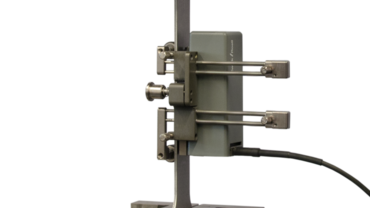
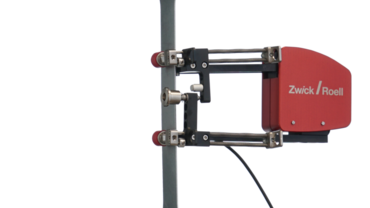
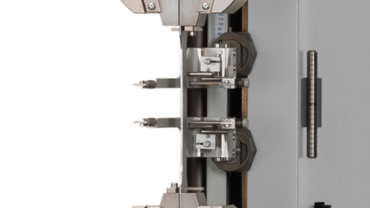
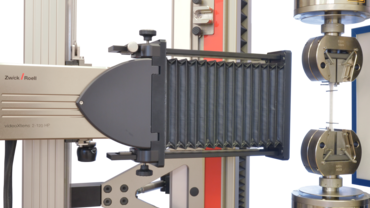
適用於 ASTM D638 的 ZwickRoell 延伸計
根據您的要求,ZwickRoell 可提供各種延伸計,其中大多數符合 ASTM E83 的準確度 B-2:
- 非接觸式 videoXtens 用於高解析度和高準確度的光學非接觸式測量。videoXtens 具有寬廣的量測範圍,從彈性模數的測定到試樣應變均可達到 >100%。裝置可自動夾持於試樣上,無需人工操作。您可以選擇整合橫向應變測量並使用溫度控制設備。
- makroXtens 適用於機械探測測量,具有非常高的解析度和準確度。makroXtens 具有較寬的測量範圍,從模量測量到試樣應變均達到 >100%。附著到試樣上是自動的。無需拆下感測器手臂即可進行測量直至試樣斷裂。您可選擇整合橫向應變測量並使用溫箱。
- multiXtens將拉伸模量之測量與試樣斷裂時的高應變測量相結合。 其亦具有高達 740 毫米的行程範圍並可在測試不同的材料時使用,例如:具極高試樣伸長率的脆性塑膠及彈性體。
- 手動連接夾持式延伸計用於具有非常高的分辨率和準確度的機械探測測量。延伸計由操作人員在測試前手動安裝於試樣上,一旦達到最大測量位移或試樣斷裂前將手動移除。根據不同型號,您可選擇的測量範圍約為 2 mm 至 25 mm,滿足各種材料與測試需求。
- 機械式長行程延伸計測量中至大型試樣應變,適用於降服伸長率及斷裂伸長率。自動連接試樣,無需拆下感測器手臂即可進行測量直至試樣斷裂。
- longstroke 光學式長行程延伸計透過追蹤反光標記來量測中至大範圍的試樣應變,適用於測定降服延伸率與斷裂延伸率。可進行自動連接,標記距離測量之操作相同; 並可進行測量直至試樣斷裂。
ASTM D638標準中規定的預處理和環境條件
- 遵守規定的調節和環境條件,也就是溫度和濕度對於測試結果的比較極為重要。
- 有關調節期限的規範可參閱被測試塑料的相關材料標準。 此外,用於成型材料測試的試片必須保持在標準環境(標準的溫度和濕度條件)中放置至少16小時才能進行測試。
- 若於標準大氣中進行試驗,則指ASTM D618 中規定的正常氣候。
適度的環境: 23 ± 2 °C,50 ± 10 %rh
亞熱帶氣候: 27 ± 2 °C,65 ± 10 %rh - 對應於公差為 2。 公差即為一半 1。
- 室溫通常指的是一個相對寬的溫度範圍,在18 °C和28 °C之間。
- 測試也可以在高溫或低溫下進行,但是可能會相應指定不同的要求。
在同一時間範圍內進行更多測試:提高塑膠測試實驗室的試樣吞吐量
對於根據 ASTM D638 進行的拉伸測試,從每天測試 10 個試樣起經證明可能為值得的自動化解決方案。 我們的roboTest N 試驗助手可承擔簡單的拾放任務,並於測試實驗室中提供經濟高效的支援。
對於高測試要求的實驗室,推薦我們的自動化測試系統roboTest L。我們用於大批量塑膠測試的主力裝置可容納450 個試樣。 根據 ASTM D638 自動執行試樣橫斷面測量及拉伸測試。 於測試後,將試樣殘留物從夾具上取下。
但其他試樣形狀或其他測試方法對於我們的自動化測試系統而言也不成問題。 自動化測試系統 roboTest R更為複雜,可連接至第二或第三台試驗機,以及對中站或 -80 °C 至 +360 °C 溫箱等附加裝置。不僅可提升試樣測試量,更提供並行執行不同測試的選項,以獲得快速可靠的測試結果。
有關 ASTM D638 的常見問題
長纖維增強塑膠材料(如 GRC 或 CRC)依 ASTM D3039 標準進行拉伸測試。根據層壓材料或織物的方向和結構,這些材料可具有非常不同的特性。由於其材料特性,通常需搭配特殊設計的試樣與測試方法。
ASTM E132 標準明訂出適於環境溫度下測量蒲松比之測試方法。 然而,對於未增強塑料,通常可用蒲松比固定值計算,因為此值基本上為恆定狀態。
這項標準是根據 ASTM D618 方法 A 在調整狀態下對試樣進行的測量。然而,ASTM D638標準允許在調節和測量要求上有所偏差,因此可依據該標準在低溫或高溫條件下進行測試。
ASTM D638 標準涵蓋拉伸特性的測定,包括非強化和強化塑料的拉伸強度。 用於拉伸測試的其他常用標準包括用於金屬的ASTM E8 / ASTM E8M、用於橡膠和彈性體的ASTM D412,以及用於纖維強化材料的ASTM D3039
